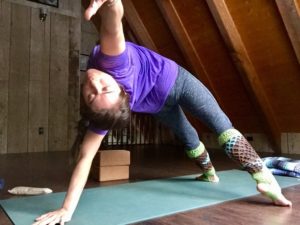

I personally think a better question to ask is, “what isn’t yoga?”. Why flip the script? Honestly, yoga has an image problem, and all the comments and questions I get in response to invitations to practice with me confirm that.
What Folks Say:
“I can’t touch my toes”
“I have a bad back”
“I’m as flexible as a board”
“Do you do those crazy poses I see on Instagram?!?”
What Yoga Isn’t:
It’s not cardio. If you want to breath fast and hard, there are many ways I can suggest you move or exercise. I prefer a slow flowing class so that each movement is mindful, and you have time to reflect on the sensations happening in the body core to skin. Does this feel good? How is it benefiting my body? Can I make this position more comfortable for me? What can I do to target the area I am seeking to focus on and support today? You’ll have time to ask and answer these questions in a casual to moderate paced class with me.
It’s not being extremely flexible. That image problem I was referring to in the beginning has a lot to do with the skinny, white, woman we all see back bending on a beach so that her toes meet her head! Yikes! As a practitioner first and foremost, there are many poses that I no longer do, like that beach lady. Why? Simply because I asked myself, “how is this serving my body and well being?”. If it wasn’t serving me, then I stopped doing it! I consider this same question when I choose the movements, alignment, and poses I teach. Does it serve your health to bend the back? Yes. Does it serves you more to touch your toes to your head? Most likely not! Instead, I work to bring functional stretch and strength, to keep you mobile within your own body’s limits, to improve your daily life.
It’s not just for young women. It’s for anyone seeking to benefit their body. If you are a working person, and the physical demands on your body are taking a toll on your health and well being, then come to a class and feel better! If you are aging and concerned about staying mobile through the next stage(s) of your life, then come to a class and feel better! If you’re a parent, caregiver, or partner and reaching maximum giving, then come to a class, and yes, feel better. My approach to teaching is to be thoughtful of the ways we all move (or don’t move) throughout our day and lives. I ask myself, how can I serve to counter the aches, pains, and overuse (or underuse) of the people before me? How can I help fill their cups back up, so that they may go back out into the world and serve others to their fullest? If you come to a class, I will do my best to meet you wherever you are on the mat that day!
These three points are not definitive qualifiers for yoga as a whole. As a practitioner and a teacher, this is what yoga is NOT to/for me. It should be said, it takes all kinds of kinds, and these are my opinions.
What Yoga Is:
Many ideas and images get conjured up when someone hears the word Yoga. The simplest way I define its roots from India (dating back 5,000+/- years) is to say that it is an ancient spiritual practice (in relation to the human spirit). Through wholesome actions, devotion to love all well, self-study, and inner reflection by way of meditation we learn to ‘see’ the Divine, and realize we are all connected. The Divine can be identified by your individual terms. I usually end a class by saying, “the light in me, the light in you, the light in all of us that shines brightly, I ‘see’ and honor it. Namaste”. The divine that connects us all, that light, I see and honor it, and namaste can be translated to mean, I bow to the divine in you. Then I literally bow to you all with my head. It’s respect, it’s acknowledgement, and it’s another language. Sanskrit too is ancient, about 3,500 years, and it’s simply the way another group of people communicated.
Yoga is a way of living your life. Consider it ancient Philosophy 101. Centered around the mind it focuses on exisistence, living, knowledge, values, reason, questioning, discourse, justice, death, and much more. Without going too deep, there are also ancient Indic texts: the Vedas, the Upanishad (part of Vedas), and the Bhagavad Gita (mythology) that teach fables, tell of glorified mythical battles, all in relation to life lessons, truths and principles of living. There is also the Yoga Sutras, written by one of the earliest famous yoga philosophers, Pantanjali. His sutras (threads) of knowledge were gathered from these ancient thoughts into one text, for unifying the mind, body, and spirit. It’s also the first historical mention of physical poses or asanas, which were meant to help still the body for mindful reflection. An oral tradition began for many years, until we arrive in the modern era of gurus (teachers or guides that dispels darkness and brings light) in the 19th and 20th centuries. These men (it took many years before there were also women) brought the physical poses to the West, in a format that would allow us to access the philosophy of the East in a digestible format. There had also been a heightened awareness of physical movement being a productive way to keep the shell (our body) of our spirit healthy.
To be honest, I do not teach much of the ancient roots of Yoga. I myself have only dipped a toe into that ocean of knowledge. In the future, as I become more advanced and confident in my learning, I hope to share the vast and deep principles of capital Y Yoga. What I do teach are the poses, to access the calm mind, to create body awareness, to tap into the well of our inner strengths in reflection of the outer strength we gain as we move. What yoga is for me as a teacher is: stability, ability, and strength, inside and out. I try not to ‘preach’ too much positivity, but have been known to plant a few nuggets here and there. Mostly, I want you to feel better, so that you can be the best version of yourself for others and the world!
Bend and Benefit:
There is truth and science to the physical law of ‘a body in motion stays in motion’. When you stretch and move you are inviting pliability and lubrication into the body (so don’t forget to stay hydrated!). Water makes up a large percentage of our bodies, it’s stored in all of our tissues, and when we move it helps to flush out waste and to bring in good nutrients for health and healing throughout the entire body. Mobility (our individual ranges of free, uninhibited motion) is the key to aging well. Don’t take for granted your youthful ability to sit, squat, or balance! Instead, curate it, and find longevity. Yes stretching is part of mobility, but staying strong within your complete range of motion is the jelly to your peanut butter. Muscle strength comes from doing work, as in loading the body with our own weight to stimulate the muscles to adapt. Lunges, push ups, and back bending with control can aid our bodies in keeping a healthy range of strength (not to mention relieve a few aches and pains). Finally, it’s no scientific secret that breathing well has benefits too. While we stretch, strengthen, and mobilize our bodies, we can unite our breath with our movements for a whole package of mindful movements.
Call to Action
Move With Me!!! If any of these words resonate with you, please join me for a class sometime soon. I also do private lessons and have a YouTube channel with videos of various length for self practice. Connect with me if you have any further questions. I’m happy to help or refer you to a good resource. The links below are largely where I obtained the information for this post, and are also some of my favorite teachers to learn from.
~Namaste,
Valarie
valariefanderson@gmail.com
Does Stretching Weaken Our Muscles
Strength Training is also Mobility Training
Belly Breathe- Why I don’t do it anymore
Fascial Fluid Dynamics
Yoga for Low Back Pain
How to Sit
Ananda.org
